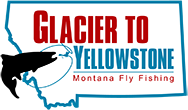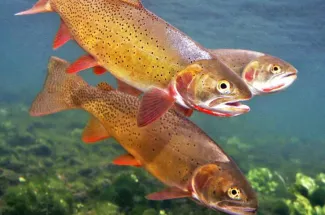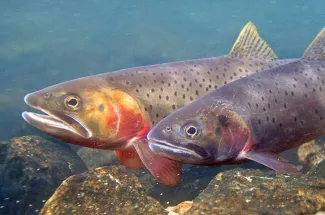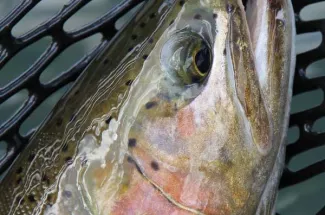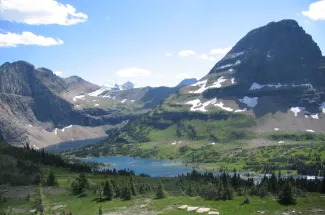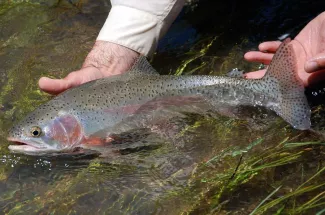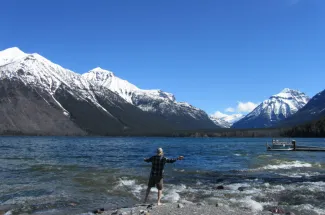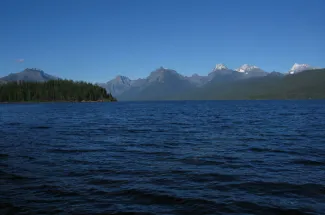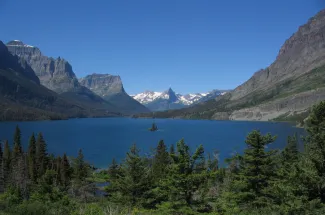Covering 1,584 square miles of majestic mountains and icy glaciers, the mountainous wonders of Glacier National Park are viewed by over two million visitors a year. Unlike Yellowstone National Park, which is a Mecca for fly fishers from all around the country, Glacier National Park is not well known as a fishing destination. It does, however, offer some quality fishing in addition to its breathtaking scenery and world class hiking. While there are some stream fishing opportunities, Glacier also offers good fishing in over 50 lakes for those anglers who are willing to trek three to six miles or more into the interior lakes. Consider the fishing an added bonus to a scenic hike into the wilderness.
Avalanche Lake
Avalanche Lake is one of the most popular hiking destinations in Glacier National Park. The lake sits in a sub-alpine bowl, surrounded by high, craggy cliffs and waterfalls. The fishing is good here for small Westslope Cutthroat Trout. The lake is small enough to fish from shore, but a float tube helps.
Belly River
Located in the extreme northeastern corner of the park, the Belly river flows north into Canada, one of the very few Montana streams that are a part of the Hudson Bay drainage. A backcountry stream for most of its length, the Belly offers fair fishing for Rainbow and Cutthroat Trout.
Elizabeth Lake
Elizabeth Lake is one of just a few places in the lower 48 states where anglers can catch both rainbow trout and arctic grayling, and big ones at that! The lake is quite large, and most anglers concentrate at the foot of the lake and the inlet. The trout and the grayling cruise along the shelf where the clear, shallow water meets the impenetrable green-blue line of water, which is produced by glacial silt. Grayling and trout reach 14 to 16 inches and larger ones are possible.
Hidden Lake
Hidden Lake is another of Glacier Park's most popular hikes, although most visitors turn back at the overlook and do not finish the trek to the lakeshore. The trail begins at Logan Pass, one of the Park's most spectacular sights. Fishing is good here for introduced Yellowstone Cutthroat Trout, some of which grow quite large.
Many Glacier Lakes
Resembling the European Alps with its stunning vistas and four glaciers, Many Glacier Valley has attracted visitors since the Many Glacier Hotel opened in 1914, just four years after the formation of the Park. The Many Glacier Valley offers visitors the opportunity to view wildlife such as the powerful grizzly bear and the agile mountain goat and bighorn sheep. Fishing opportunities include the valley lakes as well as the backcountry lakes. However, some of the lakes, are barren or closed to fishing.
McDonald Creek
McDonald Creek, draining McDonald Lake and entering the Middle Fork of the Flathead River, receives a great deal of fishing pressure because of its accessibility and scenic allure. To protect the cutthroat populations, the Park established catch-and-release fishing restrictions using single hooks between Lake McDonald and the Quarter-Circle Bridge. Slow, clear water provides a challenge for those fly fishers who enjoy delicate casting with long leaders and small tippets.
McDonald Lake
Located just inside the West Entrance, McDonald Lake is the first sight for many visitors to Glacier National Park. This large, deep lake is best fished from a boat, and this is one of the few places in the park where motor boats are allowed. Shore fishing is generally poor, but the lake does have a good population of introduced Lake Trout as well as some native Cutthroats.
North Fork Lakes
The west side of Glacier National Park is dominated by long, narrow valleys that drain down into the North Fork of the Flathead River. These steep, heavily timbered valley's contain a myriad of lakes, most with a decent population of fish. The lakes are all reached from the Inside North Fork Road.
Two Medicine Lakes
The Two Medicine area is tucked into the South-east corner of Glacier Park, and is generally a bit more quiet that other areas of the park. It features a chain of lakes, starting with large, low elevation lakes and gradually continuing upwards to high alpine ponds.
